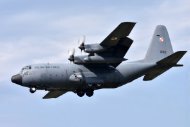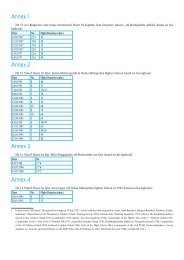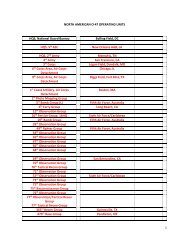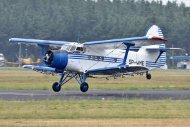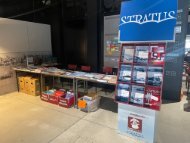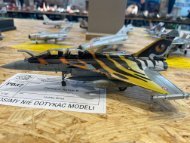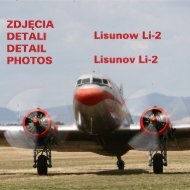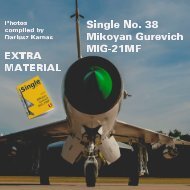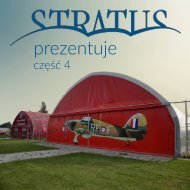B-17 CC Additional Material by Robert M Stitt
Boeing B-17 Fortress in RAF Coastal Command Service Second Edition Robert M Stitt Additional Material
Boeing B-17 Fortress in RAF Coastal Command Service
Second Edition
Robert M Stitt
Additional Material
- No tags were found...
You also want an ePaper? Increase the reach of your titles
YUMPU automatically turns print PDFs into web optimized ePapers that Google loves.
onto the northern Solomons, New Britain and, most importantly, northern New Guinea. The necessary<br />
build up of strength was met <strong>by</strong> dispatching a convoy of six destroyers and five transports from Rabaul<br />
to the port of Lae on January 6, 1943, with a portion of the 51 st Division under the command of Major<br />
General Tooru Okabe.<br />
Anticipating this move, General Kenney ordered a major bombing raid on Rabaul for January 5, to<br />
destroy as much shipping as possible before it could be used to reinforce Japanese positions on the New<br />
Guinea mainland. Contrary to Kenney’s direct orders, General Walker flew on the mission and was lost<br />
when B-<strong>17</strong>F 41-24458 San Antonio Rose was shot down <strong>by</strong> a combination of flak and Zero-Sen fighters.<br />
Attempts were made to attack the Lae-bound convoy before dark without any results, though the<br />
crew of a solitary Consolidated Catalina of 11 Squadron, RAAF, A24-1, under the command of Flt Lt<br />
David Vernon, achieved a remarkable success that night when they stalked and sank one of the transports,<br />
the Nichiryu Maru. The following day, the Allies launched a major aerial campaign to prevent<br />
the convoy reaching Lae. Starting in the early hours of the morning, American and Australian aircraft<br />
flew 154 sorties and dropped over 250 large bombs. Yet <strong>by</strong> 3:45pm, the four remaining transports had<br />
reached Lae harbour and only one, the Myoko Maru, was seriously damaged and subsequently ran itself<br />
aground. An estimated 4,000 Japanese soldiers and their equipment made it ashore.<br />
With a substantial number of Japanese troops now landed at Lae, the focus for Allied operations on<br />
January 8 became disrupting their movements, destroying their supplies and sinking the ships before<br />
they left the harbour. As on the previous day, American and Australian units contributed a diverse force<br />
of aircraft that included B-<strong>17</strong>s, Consolidated B-24 Liberators, Martin B-26 Marauders, North American<br />
B-25 Mitchells, Lockheed P-38 Lightnings, Douglas A-20 Havocs and Bristol Beaufighters and Beauforts.<br />
Ray Dau and his crew were assigned B-<strong>17</strong>E 41-9234 and tasked with bombing the escorting destroyers<br />
– this was to be their first mission originating from Port Mores<strong>by</strong> and their thirteenth in all. Donald<br />
Hoggan’s diary captures the start of that fateful day.<br />
Friday, January 8: Arrived at operations 5am, waiting to strike convoy at Lae. Took off about 10am, 7<br />
ships to go. We circle over airdrome at 6,000 waiting for ships to form but [they] do not [arrive] so take off<br />
for Lae… in a two-ship formation.<br />
Rau Dau formated 41-9234 on the right wing of B-<strong>17</strong>F 41-24381 Panama Hattie, flown <strong>by</strong> Capt.<br />
William M Thompson of the 63 rd BS – the two unescorted bombers then set course across the Owen Stanley<br />
Range, arriving at Lae harbour at 11:45. Ray Dau describes the reception. “Prior to reaching the harbor we<br />
could see heavy ack-ack and a lot of fighters. It was the first time we’d encountered such heavy concentrations.<br />
Our other missions had been fairly routine… but this one was different. We came into the harbor area<br />
from the sea side and everything happened at once. I was concentrating on keeping on Thompson’s wing for<br />
our run. The ack-ack was hitting us and the Zeros were coming in with head-on attacks and swerving up<br />
over the plane… we were getting hit from every direction. I knew that bombardier ‘Bud’ Cole was hit almost<br />
simultaneously with all this action... I knew too that our number 3 and 4 engines were shot out.”<br />
Despite the mayhem around him, Cole remained focused on dropping his bombs on the Japanese<br />
destroyers. As he squinted through the Norden bomb sight he became aware of an approaching<br />
Zero-Sen and at that instant was hit in the face <strong>by</strong> a cannon shell. About the same time an anti-aircraft<br />
shell smashed into the nose section, shattering the Perspex and filling both of Coles’ knees with shrapnel<br />
– fortunately, the bomb sight protected the rest of his body. Though seriously wounded, Cole cou-<br />
Hudsons of 1 OTU, RAAF<br />
at Wau airstrip on either<br />
January 8, 1942, the day of<br />
the B-<strong>17</strong>’s crash-landing, or<br />
January 10, the day of the<br />
rescue mission. Note the<br />
steep downward slope of the<br />
airstrip behind the aircraft<br />
and that the engines have<br />
been left running for a quick<br />
departure. (Owen Robinson<br />
Collection via David<br />
Vincent)<br />
9



